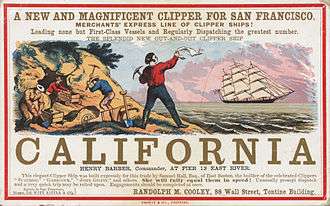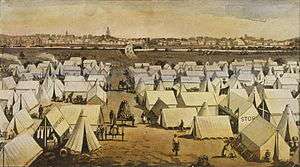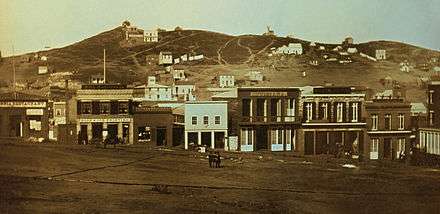Boomtown
A boomtown is a community that undergoes sudden and rapid population and economic growth, or that is started from scratch because of an influx of people. The growth is normally attributed to the nearby discovery of a precious resource such as gold, silver, or oil, although the term can also be applied to communities growing very rapidly for different reasons, such as a proximity to a major metropolitan area, huge construction project, or attractive climate.
First boomtowns

Early boomtowns, such as Leeds, Liverpool, and Manchester, experienced a dramatic surge in population and economic activity during the Industrial Revolution at the turn of the 19th century. In pre-industrial England these towns had been relative backwaters, compared to the more important market towns of Bristol, Norwich, and York, but they soon became major urban and industrial centres. Although these boomtowns did not directly owe their sudden growth to the discovery of a local natural resource, the factories were set up there to take advantage of the excellent Midlands infrastructure and the availability of large seams of cheap coal for fuel.[1]
In the mid-19th century, boomtowns based on natural resources began to proliferate as companies and individuals discovered new mining prospects across the world. The California Gold Rush of the Western United States stimulated numerous boomtowns in that period, as settlements seemed to spring up overnight in the river valleys, mountains, and deserts around what was thought to be valuable gold mining country. In the late 19th and early 20th centuries, boomtowns called mill towns would quickly arise due to sudden expansions in the timber industry; they tended to last the decade or so it took to clearcut nearby forests. Modern-day examples of resource-generated boomtowns include Fort McMurray in Canada, as extraction of nearby oilsands requires a vast number of workers, and Johannesburg in South Africa, based on the gold and diamond trade. The biggest boomtown in the early 21st century is in North Dakota, where oil fields are being exploited.
Attributes
Boomtowns are typically characterized as "overnight expansions" in both population and money, as people stream into the community for mining prospects, high-paying jobs, attractive amenities or climate, or other opportunities. Typically, newcomers are drawn by high salaries or the prospect of "striking it rich" in mining; meanwhile, numerous indirect businesses develop to cater to workers often eager to spend their large paychecks. Often, boomtowns are the site of both economic prosperity and social disruption, as the local culture and infrastructure, if any, struggles to accommodate the waves of new residents. General problems associated with this fast growth can include: doctor shortages, inadequate medical and/or educational facilities, housing shortages, sewage disposal problems, and a lack of recreational activities for new residents.[2]
The University of Denver separates problems associated with a mining-specific boomtown into three categories:[2][3]
- deteriorating quality of life, as growth in basic industry outruns the local service sector’s ability to provide housing, health services, schooling, and retail
- declining industrial productivity in mining because of labor turnover, labor shortages, and declining productivity
- an underserving by the local service sector in goods and services because capital investment in this sector does not build up adequately
The initial increasing population in Perth, Australia (considered to be a modern-day boomtown) gave rise to overcrowding of residential accommodation as well as squatter populations.[4] "The real future of Perth is not in Perth’s hands but in Melbourne and London where Rio Tinto and BHP Billiton run their organizations", indicating that some boomtowns’ growth and sustainability are controlled by an outside entity.[4]
Boomtowns are typically extremely dependent on the single activity or resource that is causing the boom (e.g., one or more nearby mines, mills, or resorts), and when the resources are depleted or the resource economy undergoes a "bust" (e.g., catastrophic resource price collapse), boomtowns can often decrease in size as fast as they initially grew. Sometimes, all or nearly the entire population can desert the town, resulting in a ghost town.
This can also take place on a planned basis. Since the late 20th century, mining companies have developed temporary communities to service a mine-site, building all the accommodation shops and services, using prefabricated housing or other buildings, making dormitories out of shipping containers, and removed all such structures as the resource was worked out.
Examples of boomtowns
Australia

- Ararat (1850s Victorian Gold Rush)
- Ballarat (1850s–1880s Victorian Gold Rush)
- Bathurst (1850s Australian gold rushes)
- Bendigo (1850s–1880s Victorian Gold Rush)
- Brisbane (1980s–2000s due to internal Australian migration trends)
- Broken Hill (1880s silver-lead-zinc boom)
- Castlemaine (1850s Victorian Gold Rush)
- Charters Towers (1870s gold rush)
- Gold Coast (1980s–2000s due to internal Australian migration trends)
- Kalgoorlie (1890s gold rush)
- Melbourne (1850s–1880s Victorian Gold Rush and associated speculative "land boom")
Brazil
- Altamira, Pará
- Balsas, Maranhão
- Brasília, Federal District, development of capital
- Goiânia, Goiás
- Laranjal do Jari, Amapá
- Luís Eduardo Magalhães, Bahia
- Ouro Preto, Minas Gerais (Ouro Preto Gold Rush)
- Palmas, Tocantins
- Parauapebas, Pará
- Rondonópolis, Mato Grosso
- Serra Pelada District, Curionópolis, Pará (Serra Pelada Gold Rush)
- Sinop, Mato Grosso
- Sorriso, Mato Grosso
- Tucuruí, Pará
Canada
- Calgary, Alberta (during the 1970s oil boom in the province of Alberta)
- Dawson City, Yukon (Klondike Gold Rush)
- Edmonton, Alberta
- Elliot Lake, Ontario
- Estevan, Saskatchewan
- Faro, Yukon
- Fisherville, British Columbia (gold rush boom town of 1864–1865)
- Barkerville, British Columbia
- Fort McMurray, Alberta
- Guelph, Ontario
- Greater Sudbury, Ontario
- Kirkland Lake, Ontario
- Sept-Îles, a city in the Côte-Nord region of eastern Québec, Canada
- Sydney, Nova Scotia
- Yellowknife, Northwest Territory
United Kingdom
- Aberdeen, North Sea oil boom, known as the "oil capital of Europe"
- Barrow-in-Furness, late 19th and early 20th centuries as the world's largest steelworks and major shipyard
- Belfast, Northern Ireland, fastest-growing settlement in the British Isles in the 19th century due to industry and its port
- Jarrow
- Leeds
- Liverpool, industry and shipping, emigrants
- Manchester, rapid economic growth in the early 19th century
- Milton Keynes
- Preston, Lancashire, boomtown of the Industrial Revolution
- Winster, Derbyshire, England (17th century lead mining community)
United States

- Atlanta, Georgia (rapidly rebuilt and became a commercial center in the years following the civil war)
- Atlantic City, New Jersey resort boomtown, 1870-1940
- Beaumont, Texas, oil
- Belleville, California, gold mining boomtown, 1860–1870
- Birmingham, Alabama, coal and iron ore, 1680s
- Bodie, California
- Borger, Texas
- Burkburnett, Texas
- Butte, Montana, copper and other resources
- Caldwell, Kansas
- Central City, Colorado
- Chicago, Illinois, railroads, commodity resources, business
- Cincinnati, Ohio, trade, shipping
- Colstrip, Montana
- Columbia, California
- Cripple Creek, Colorado
- Deadwood, South Dakota
- Denver, Colorado
- Desdemona, Texas
- Dodge City, Kansas
- El Paso, Texas
- Elkhart, Indiana recreational vehicle and manufactured housing industry
- Ellsworth, Kansas
- Endicott, New York (shoe manufacturing boomtown, 1900s-1920s)[5]
- Evanston, Illinois[6]
- Fairbanks, Alaska, during the Klondike Gold Rush and the building of the Trans-Alaska Pipeline)
- Gary, Indiana, steel
- Gillette, Wyoming
- Goldfield, Nevada
- Graysonia, Arkansas
- Guthrie, Oklahoma, oil
- Hancock, Michigan
- Harrisburg, Illinois
- Houghton, Michigan
- Humble, Texas
- Jeffrey City, Wyoming
- Kilgore, Texas
- La Paz, Arizona, gold mining boomtown, 1862–1864
- Leadville, Colorado
- Newport, Wisconsin, sprang up because of a bridge expected to be built across the Wisconsin River there
- New Bedford, Massachusetts, whaling
- Nome, Alaska
- Odessa, Texas, oil
- Pittsburgh, Pennsylvania, steel, trade
- Richland, Washington
- Rochester, New York, starting in the 1820s, with the opening of the Erie Canal
- Sacramento, California
- St. Joseph, Florida
- San Francisco, California, US settlement after winning Mexican War
- San Luis, Arizona
- Seattle, Washington, became a prosperous port city during the Klondike Gold Rush in 1897.
- Sioux City, Iowa
- Tombstone, Arizona
- Texarkana, TX/AR
- Virginia City, Nevada, silver mining boomtown, 1860s
- Wentzville, Missouri
- Williston, North Dakota, oil
Others
- Carbonia, Italy
- Dubai, UAE, oil
- Dublin, Ireland
- Fort McMurray, Canada, oil
- Hyderabad, India
- Johannesburg, South Africa
- Karachi, Pakistan
- Kimberley, South Africa, diamonds and gold
- Monterrey, Nuevo León, Mexico
- Roubaix, France[7][8]
- Shenzhen, China
- Batam, Indonesia
References
- ↑ Brooks, Ann & Haworth, Bryan (1993). Boomtown Manchester 1800-1850. Manchester: Portico Library.
- 1 2 "No. 2, Controlling Boomtown Development". Case Studies on Energy Impacts. 1976.
- ↑ Duff, Mary K. & Gilmore, John S. (1975). Boomtown Growth Management. The University of Denver Research Institute.
- 1 2 Weller, Richard (2009). Boomtown 2050.
- ↑ Aswad, Ed; Meredith, Suzanne M. (2003). Endicott-Johnson. Charleston, SC: Arcadia. p. 43. ISBN 9780738513065. Retrieved 26 February 2015.
- ↑ "Guide to Natural Areas in Northern Illinois" (PDF). Rockford, IL: Natural Land Institute. March 2008. Retrieved 2 August 2012.
- ↑ Strikwerda, Carl (1984). Sweets, John F., ed. "Regionalism and Internationalism: The Working-Class Movement in the Nord and the Belgian Connection, 1871–1914". Proceedings of the ... Annual Meeting of the Western Society for French History. 1983/1984. Lawrence (Kansas), USA: The University of Kansas: 222. ISSN 0099-0329. Retrieved 2016-03-17.
Contemporaries never tired of calling Roubaix an "American city," because of its raw, fast-growing character, or of referring to Roubaix and its sister cities of Lille and Tourcoing as the "French Manchester."
- ↑ Clark, Peter (January 29, 2009). European Cities and Towns: 400–2000. Oxford, UK: Oxford University Press. p. 246. ISBN 978-0-199-56273-2. Retrieved 2015-10-01.
Roubaix was another new town, originally a craft village, whose many textile mills attracted a population of 100,000 and generated massive social and environmental problems.
External links
| Look up boomtown in Wiktionary, the free dictionary. |
